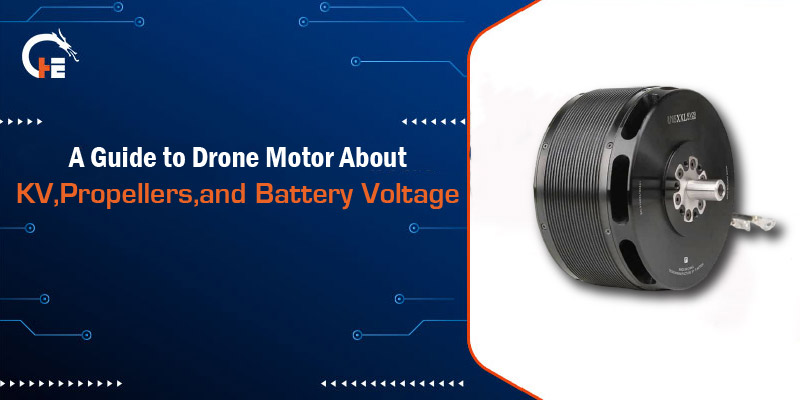
A Guide to Drone Motor About KV, Propellers, and Battery Voltage
When you start to build a drone, you will see a lot of numbers on the side of a drone motor that can be very confusing like 900KV or 2400KV. These numbers are not just for show but they are the most important part of building a drone that actually flies well. So, when it comes to choosing the right motor, it becomes all about matching it with the right propeller and the right battery. In this blog, we will go over these things and guide you so you can understand what these numbers mean and how they all work together.
Why is Matching Your Motor, Prop, and Battery Important?
A mismatch in your drone’s parts is a very common and expensive mistake for new builders. If you put a very large propeller on a motor that is made to spin very fast (a high KV motor) then you will overload the motor. This will cause it to get very hot which can burn out the motor and make your drone crash. This is a problem that is very easy to avoid with a little bit of planning.
Getting the combination right is also how you get the performance you want. A bad match can lead to a drone that feels very weak and struggles to lift itself off the ground. It can also lead to a drone that is very inefficient and only gives you a very short flight time which is not fun for anyone.
What Do These Key Numbers Mean?
Here is a simple look at the three main parts of your drone’s power system:
What is a “KV” Rating?
The KV rating of a drone motor is not a measure of its power nor strength. It is a measure of its speed. The number tells you how many times the motor will try to spin (per minute, or RPM) for every one volt of electricity you give it with no propeller on.
What is a Propeller Size?
You will see two numbers on a propeller such as 10 x4.5. The first number (10) is the length of the propeller in inches. The second number (4.5) is the “pitch,” which is how far the propeller will move the air in one single turn. A bigger propeller is like a bigger harder gear on a bicycle.
The Golden Rule
For KV and Prop Size, here is the simple rule to remember: Low KV motors are made for spinning large propellers. These are used on big drones that need to be better, High KV motors are made for spinning small and fast propellers. These are used on small racing drones that need to be very quick.
The Battery’s Role (Voltage)
The battery voltage (like a 4S or 6S battery) is what gives the motor its power and determines its final speed. A drone motor provider will always tell you what battery voltage their motor is designed to be used with. Using a battery with too high a voltage can easily burn out your motors.
(Also Read: Why Go Brushless? A Simple Guide to Brushless DC (BLDC) Motors)
How Do You Choose the Right Combination?
The right mix of parts depends on what you want your drone to do.
- For Heavy-Lift and Commercial Drones: Lightweight and powerful drone motors for commercial UAVs need to lift a lot of weight like a big camera or a delivery package. To do this, they use very large propellers that spin slowly. This is why you would choose a motor with a very low KV rating like 500KV for this kind of job.
- For Racing Drones: A racing drone needs to change direction in a split second. For customizable drone motors for heavy-lift and racing drones, you need the propellers to spin extremely fast. For this, you would choose a small propeller and a motor with a very high KV rating like 2400KV or more to get that quick response.
- For Camera and Freestyle Drones: A drone that is used for filming videos needs to be very stable in the air. The best high-quality drone motor manufacturers for precision drones will suggest a motor in the middle range. A mid-range KV motor with a mide-sized propeller gives you a good balance of power and a stable flight which is what you need for a smooth video.
- Always Check the Data: You should not just guess which parts will work together. A drone motor supplier will provide a data sheet for their motors with test results for different propellers and battery sizes which you can use to make a better choice for your build.
Wrapping Up
Building a drone that flies well is not that simple. You have to find the right balance. The secret is in matching the motor’s KV, the propeller’s size, and the battery’s voltage for your specific goals. This is how you get efficient brushless drone motors for industrial and recreational drones to perform at their best. You can visit our website to see our various options in the collection.
Contact us at info@industio.com if you need help finding the right motor combination.
Frequently Asked Questions
FAQs
What Do the Other Numbers on a Drone Motor Mean (e.g. 2207)?
Those first four numbers like 2207 or 2814 tell you the physical size of the motor’s stator which is the part on the inside. A 2207 motor has a stator which is 22mm wide and 7 mm tall. A bigger stator number like 2814 means that it is physically larger and usually a more powerful motor.
What Happens if I Use a Propeller that is too Small for My Motor?
If you put a propeller on a motor that is too small, for example a 5-inch prop on a big low-KV motor, then it will not hurt the motor. However, the drone will be very inefficient and will feel like it has no power. The motor is made to spin a much larger prop so it will not be able to move enough air to fly well.
How Does a 4S Battery Change the Performance of a Motor versus a 6S Battery?
A 6S battery has a higher voltage than a 4S battery. If you use a 6S battery on the same motor then it will spin much much faster and will create a lot more thrust. You must be very careful to use a motor that is rated to handle the higher voltage of a 6S battery or you will burn it out.

